Numerical Simulation on the Transient Temperature Field of Anode Rodding in Aluminium Reduction Cells
Abstract
1. Introduction
2. Model and Description
2.1. Geometry and Finite Element Model
2.2. Governing Equation
2.3. Material Properties
2.4. Initial Conditions and Boundary Conditions
2.5. Stub Hole-Filling Process
2.6. The Pouring Flow Chart
3. Results and Analysis
3.1. Model Validation
3.2. Solidification Process Analysis
3.3. Cooling Curves
3.4. Cooling Rate and Its Distribution
4. Conclusions
- During the filling process, the cooling rate was the fastest, and the temperature drop could reach 200 °C in certain places. At 10 s after pouring started, when the stub hole was filled up, up to 30% of cast iron by volume was solidifying. As a result, the heat transfer during stub hole-filling was non-negligible. At about 70 s, the cast iron could solidify completely.
- The cast iron close to the stub solidified prior to that which was close to carbon. The solidification mode was intermediate-freezing, transiting from skin-freezing, towards mushy-freezing. From the thermal point of view, the end-of-freeze isotherm was vertical without any cross or bridge, indicating little change of shrinkage porosity.
- The temperatures of the stub and carbon rose at first, and then reduced. The temperature of the stub was much higher, and rose up more quickly than that of the carbon. In addition, a portion of the anode assembly over 200 °C concentrated around the stub hole.
- The cooling rate of the cast iron during solidification dropped rapidly before it arrived at the liquidus temperature, and then it fluctuated. The extreme point showed up at the liquidus temperature and solidus temperature, respectively. The average cooling rate during solidification ranged from 4.3 °C·s−1 to 43.7 °C·s−1. The cooling rate gradient in the radial direction was greater than the vertical direction, and the cooling rate in the radial direction was gradually reduced from the inner wall of the cast iron to the outer surface.
Author Contributions
Funding
Conflicts of Interest
Abbreviations
| Table of symbols | |
| TCC | Thermal contact conductivity |
| Tl | Liquidus temperature |
| Ts | Solidus temperature |
| tl | Time corresponding to Tl |
| ts | Time corresponding to Ts |
| Rc | Cooling rate |
| Subscripts | |
| l | Liquid |
| s | Solid |
References
- Molenaar, D.; Kilpatrick, T.; Montalto, A. Experimental investigation of factors affecting the electrical performance of the stub to carbon connection. In Proceedings of the TMS Light Metals, San Antonio, TX, USA, 3–7 March 2013; pp. 1359–1364. [Google Scholar]
- Gunasegaram, D.R.; Molenaar, D. Towards improved energy efficiency in the electrical connections of Hall-Heroult cells through Finite Element Analysis (FEA) modeling. J. Clean. Prod. 2015, 93, 174–192. [Google Scholar] [CrossRef]
- Urrutia, A.; Celentano, J.D.; Gunasegaram, R.D. Modeling and Simulation of the Gray-to-White Transition during Solidification of a Hypereutectic Gray Cast Iron: Application to a Stub-to-Carbon Connection Used in Smelting Processes. Metals 2017, 7, 549. [Google Scholar] [CrossRef]
- Li, X. Casting Handbook: Vol. 5 Casting Process, 3rd ed.; China Machine Press: Beijing, China, 2011; pp. 20–40. ISBN 978-7-111-34171-0. (In Chinese) [Google Scholar]
- Zhang, B. Casting Handbook: Vol. 1 Cast iron, 3rd ed.; China Machine Press: Beijing, China, 2013; pp. 15–60. ISBN 978-7-111-32234-4. (In Chinese) [Google Scholar]
- Jabbari Behnam, M.M.; Davami, P.; Varahram, N. Effect of cooling rate on microstructure and mechanical properties of gray cast iron. Mater. Sci. Eng. A 2010, 528, 583–588. [Google Scholar] [CrossRef]
- Choudhary, S.K.; Ghosh, A. Mathematical model for prediction of composition of inclusions formed during solidification of liquid steel. ISIJ Int. 2009, 49, 1819–1827. [Google Scholar] [CrossRef]
- Molenaar, D.; Sadler, B.A. Anode rodding basics. In Proceedings of the TMS Light Metals, San Diego, CA, USA, 16–20 February 2014; pp. 1263–1268. [Google Scholar]
- Viswanathan, S.; Sikka, V.K.; Brody, H.D. Using solidification parameters to predict porosity distributions in alloy castings. JOM 1992, 44, 37–40. [Google Scholar] [CrossRef]
- Trempe, O.; Larouche, D.; Ziegler, D.; Guillot, M.; Fafard, M. Real Time Temperature Distribution during Sealing Process and Room Temperature Air Gap Measurements of a Hall-Héroult Cell Anode. In Proceedings of the TMS Light Metals, San Diego, CA, USA, 27 February–3 March 2011; pp. 991–996. [Google Scholar] [CrossRef]
- Pedersen, K.M.; Tiedje, N. Temperature measurement during solidification of thin wall ductile cast iron. Part 1. Measurement 2008, 41, 551–560. [Google Scholar] [CrossRef]
- Zhang, H.; Zhao, W. Thermal Measurement and Instrument (in Chinese), 2nd ed.; Metallurgical Industry Press: Beijing, China, 2006; p. 384. ISBN 978-7-5024-6435-6. [Google Scholar]
- Gunasegaram, D.R.; Molenaar, D. Rodding in Hall-Héroult Cells: An Fea Model that Predicts Room Temperature Mechanical Properties and Cracking Tendency of Thimbles. In Light Metals 2014; Grandfield, J., Ed.; Springer International Publishing: Cham, Switzerland, 2016; pp. 1287–1292. [Google Scholar]
- Holman, J.P. Heat Transfer, 10th ed.; McGraw-Hill: New York, NY, USA, 2010; pp. 139–192. ISBN 978-0-07-352936-3. [Google Scholar]
- Chaouki, H.; Baiteche, M.; Jacques, A.; Gosselin, E.; Alamdari, H.; Fafard, M. Finite Element Analysis of Slot Size Effect on the Thermal-Electrical Behaviour of the Anode. In Proceedings of the TMS Light Metals, San Diego, CA, USA, 26 February–2 March 2017; pp. 1315–1323. [Google Scholar]
- Celentano, D.J.; Cruchaga, M.A.; Schulz, B.J. On the effect of natural convection on the thermal-microstructural evolution in gray cast-iron solidification. Metall. Mater. Trans. B 2006, 37, 253–264. [Google Scholar] [CrossRef]
- Trovant, M.; Argyropoulos, S. Finding boundary conditions: A coupling strategy for the modeling of metal casting processes: Part I. Experimental study and correlation development. Metall. Mater. Trans. B 2000, 31, 75–86. [Google Scholar] [CrossRef]
- Fortin, H.; Kandev, N.; Fafard, M. FEM analysis of voltage drop in the anode connector induced by steel stub diameter reduction. Finite Elem. Anal. Des. 2012, 52, 71–82. [Google Scholar] [CrossRef]
- Allard, B.; Lacroix, S.; Noyel, J.-P.; Rivoaland, L. Modelling of collector bar sealing in cathode blocks with cast-iron. In Proceedings of the TMS Light Metals, San Francisco, CA, USA, 15–19 February 2009; pp. 1097–1102. [Google Scholar]
- Gunasegaram, D.R.; Molenaar, D. A fully coupled thermal-electrical-mechanical transient FEA model for a 3D anode assembly. In Proceedings of the TMS Light Metals, San Antonio, TX, USA, 3–7 March 2013; pp. 1341–1346. [Google Scholar]
- Plutshack, L.A.; Suschil, A.L. Riser Design. Metals Handbook—Vol. 15 Casting, 9th ed.; Stefanescu, D.M., Davis, J.R., Eds.; ASM International: Materials Park, OH, USA, 1988; pp. 617–634. ISBN 0-87170-007-7. [Google Scholar]
- Richard, D.; Fafard, M.; Lacroix, R.; Clery, P.; Maltais, Y. Aluminum reduction cell anode stub hole design using weakly coupled thermo-electro-mechanical finite element models. Finite Elem. Anal. Des. 2001, 37, 287–304. [Google Scholar] [CrossRef]

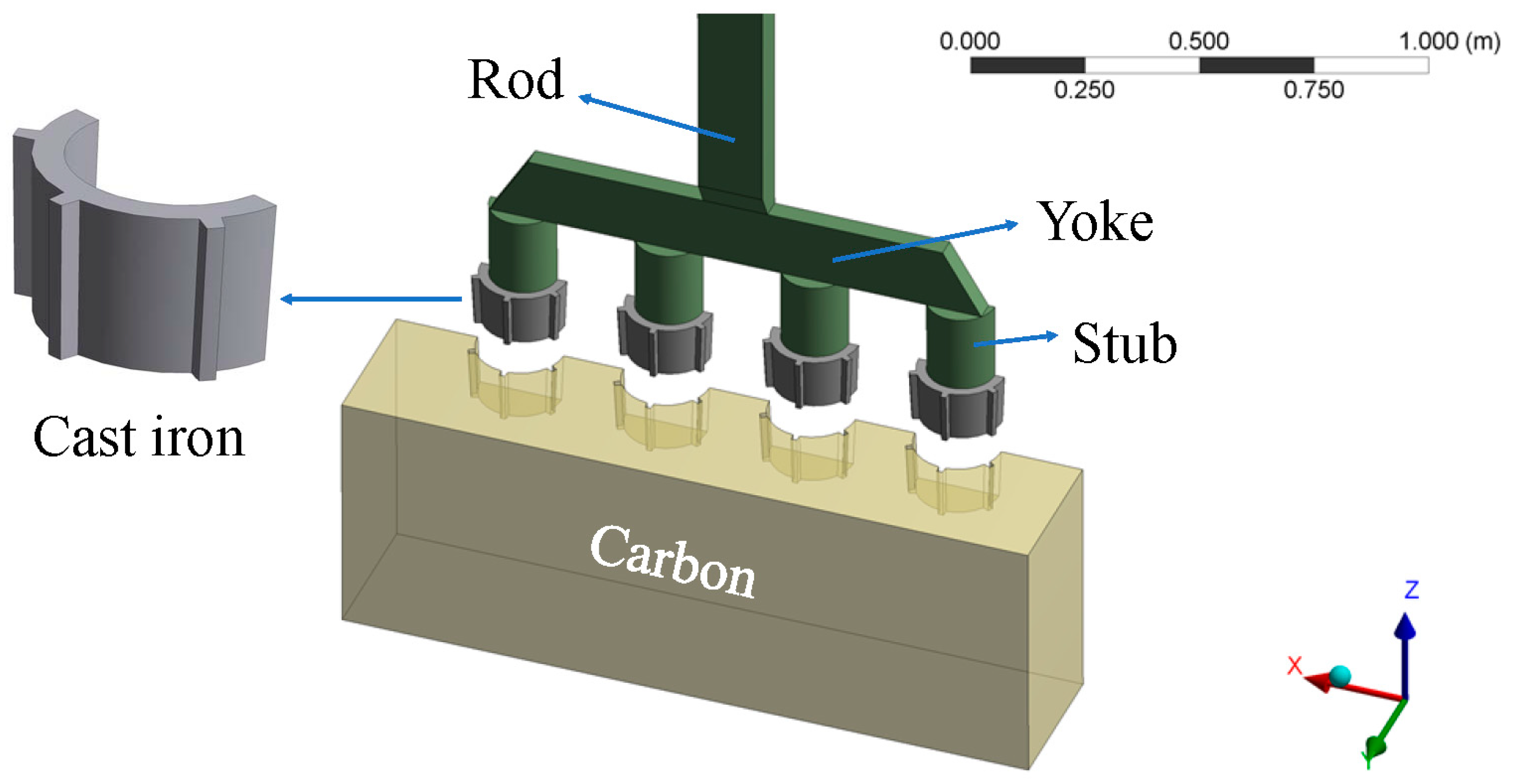
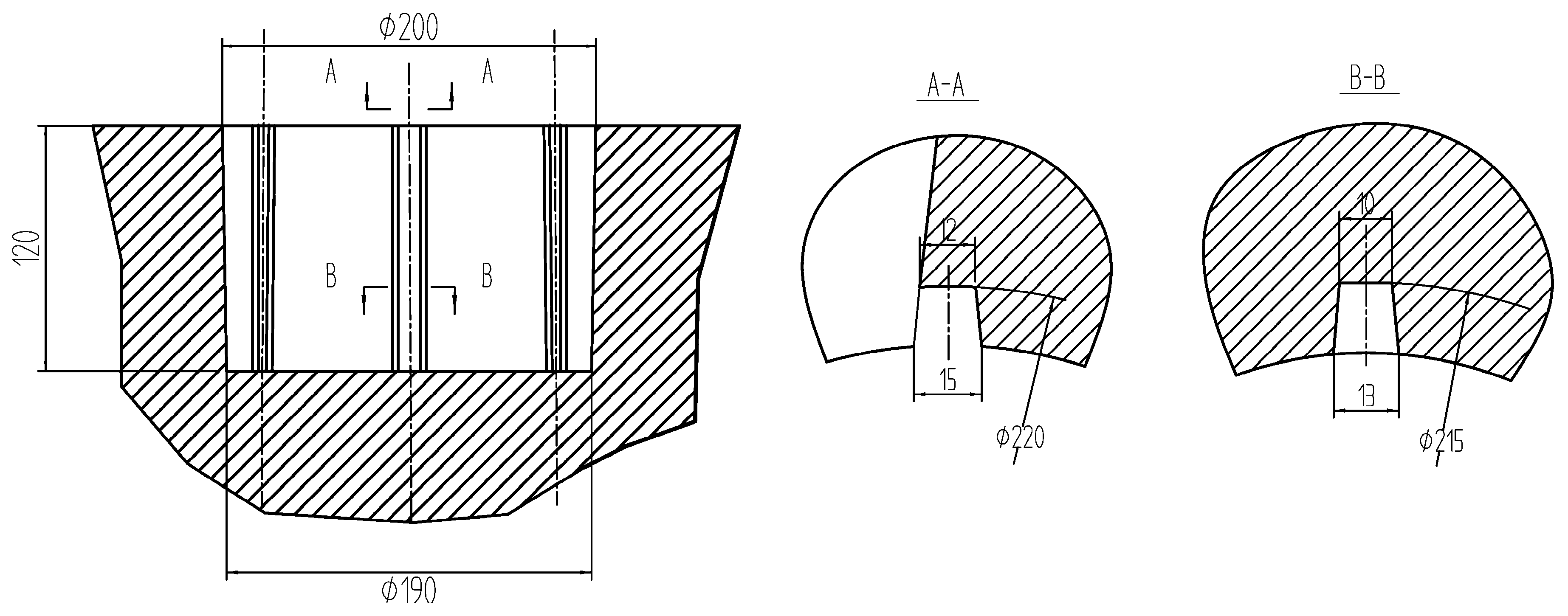
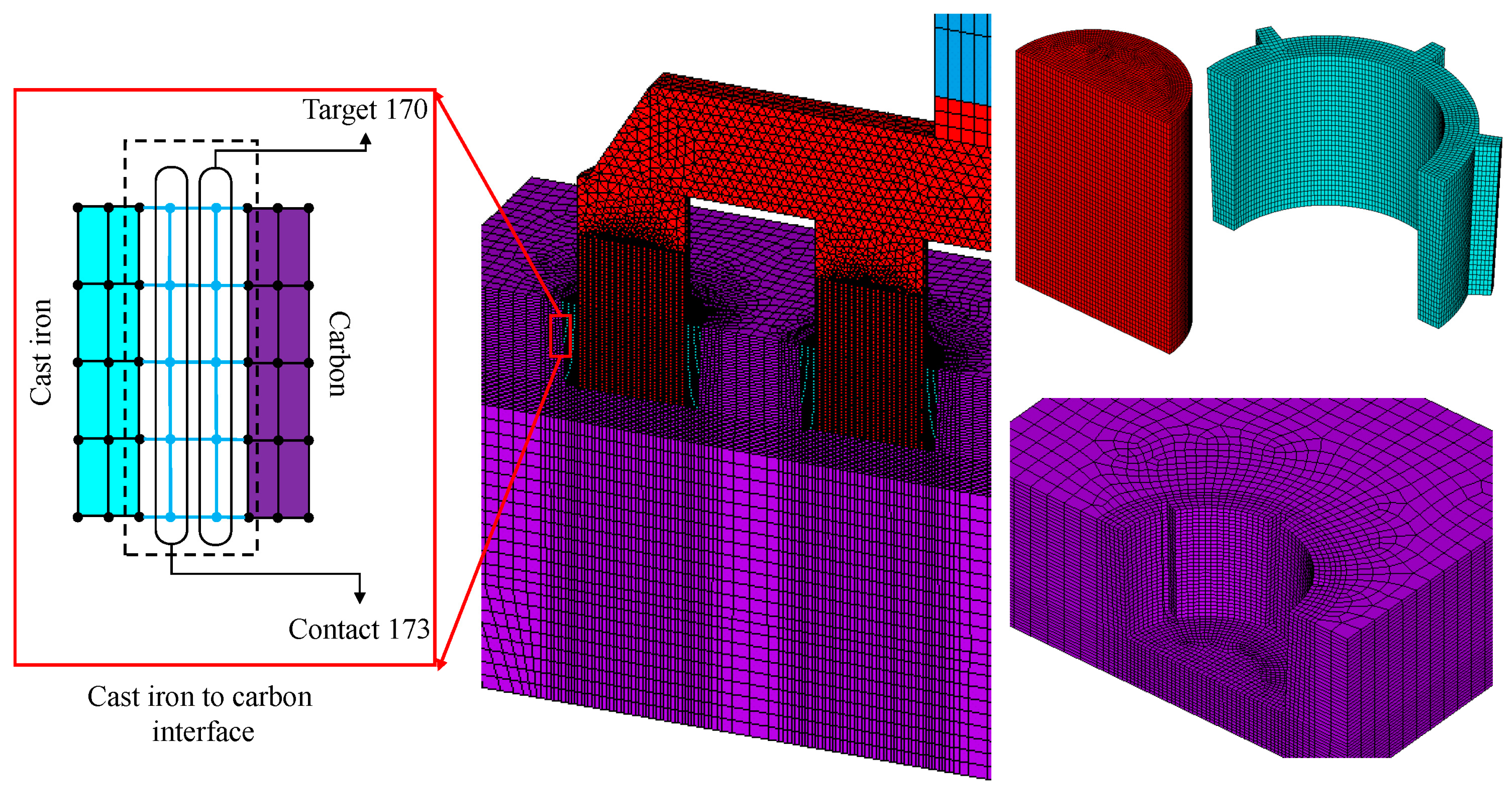
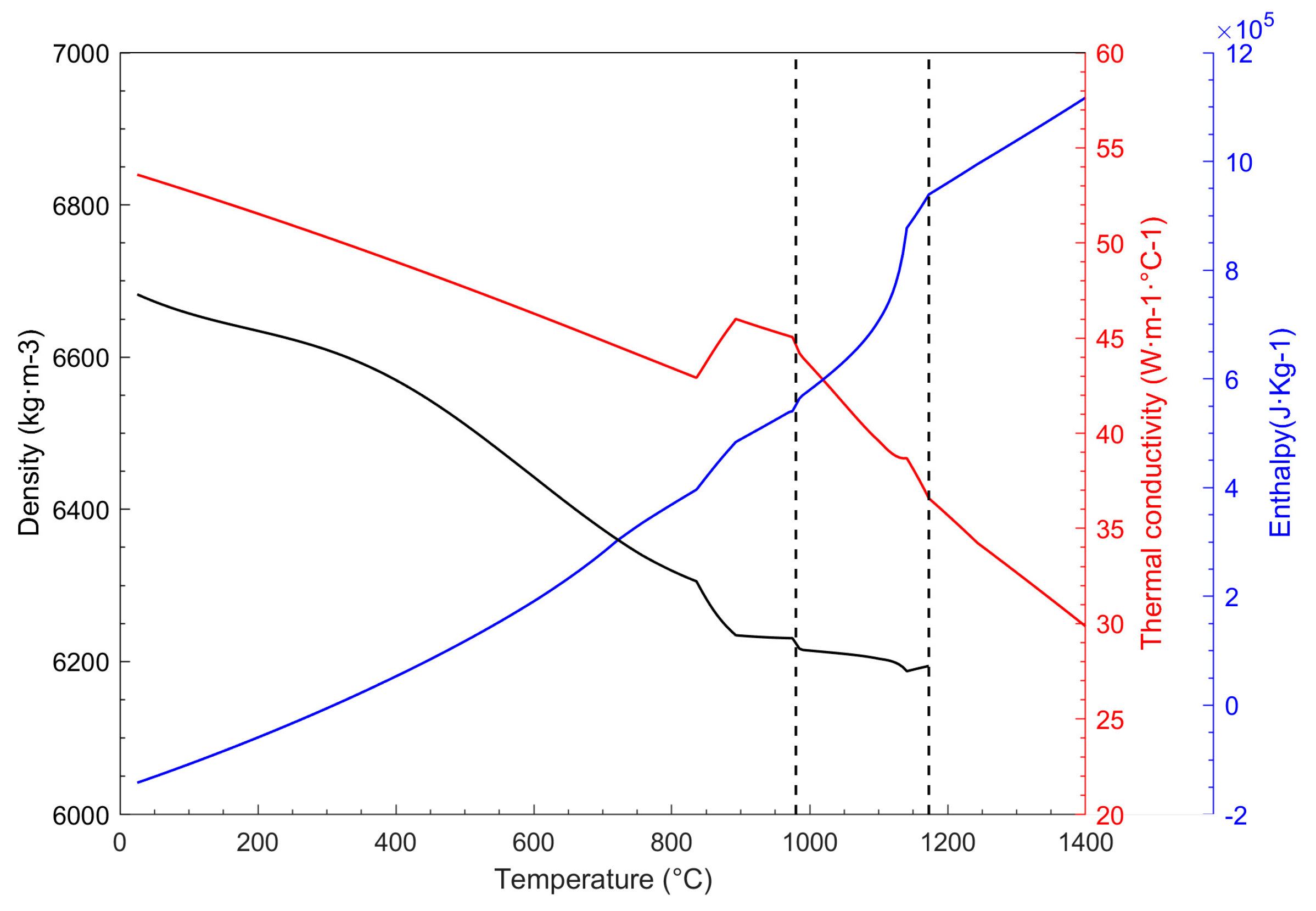
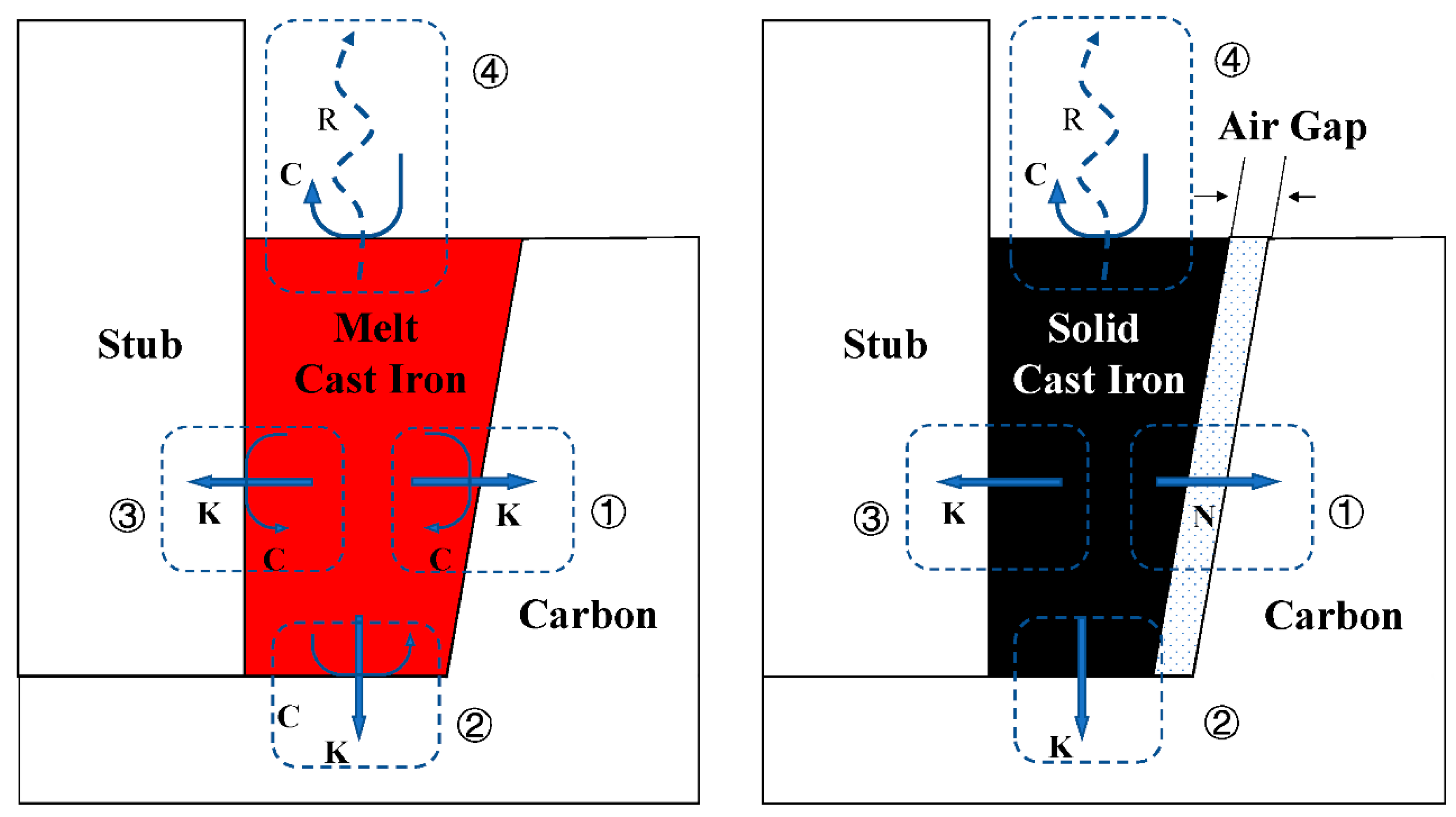



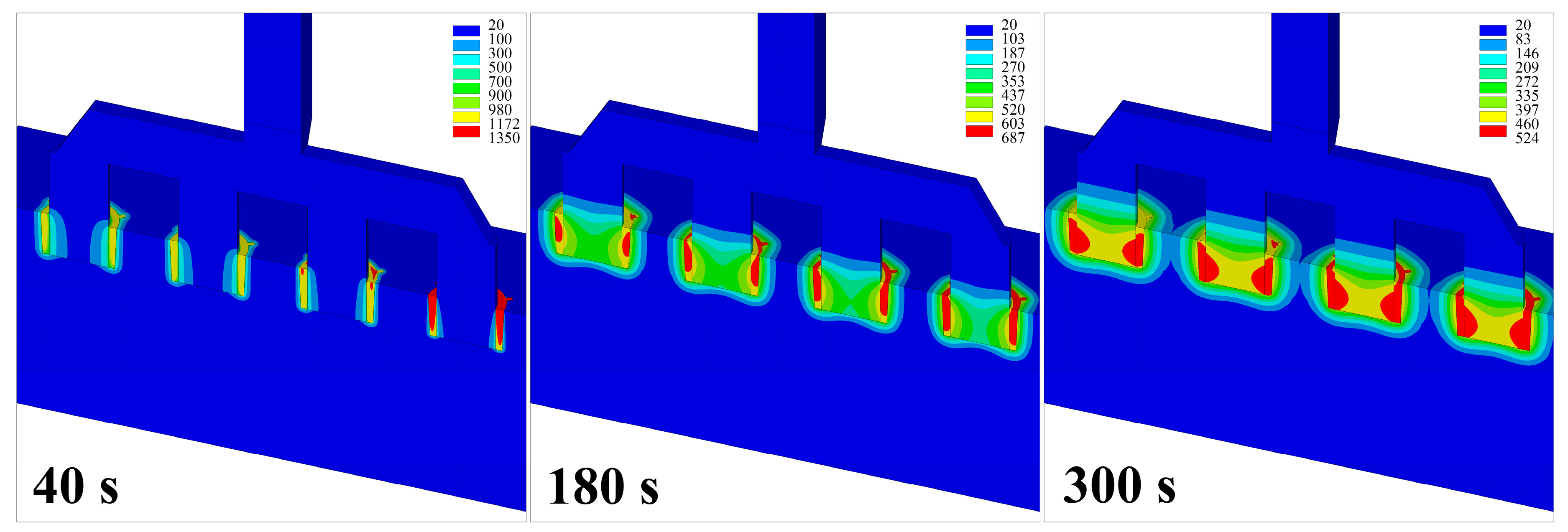
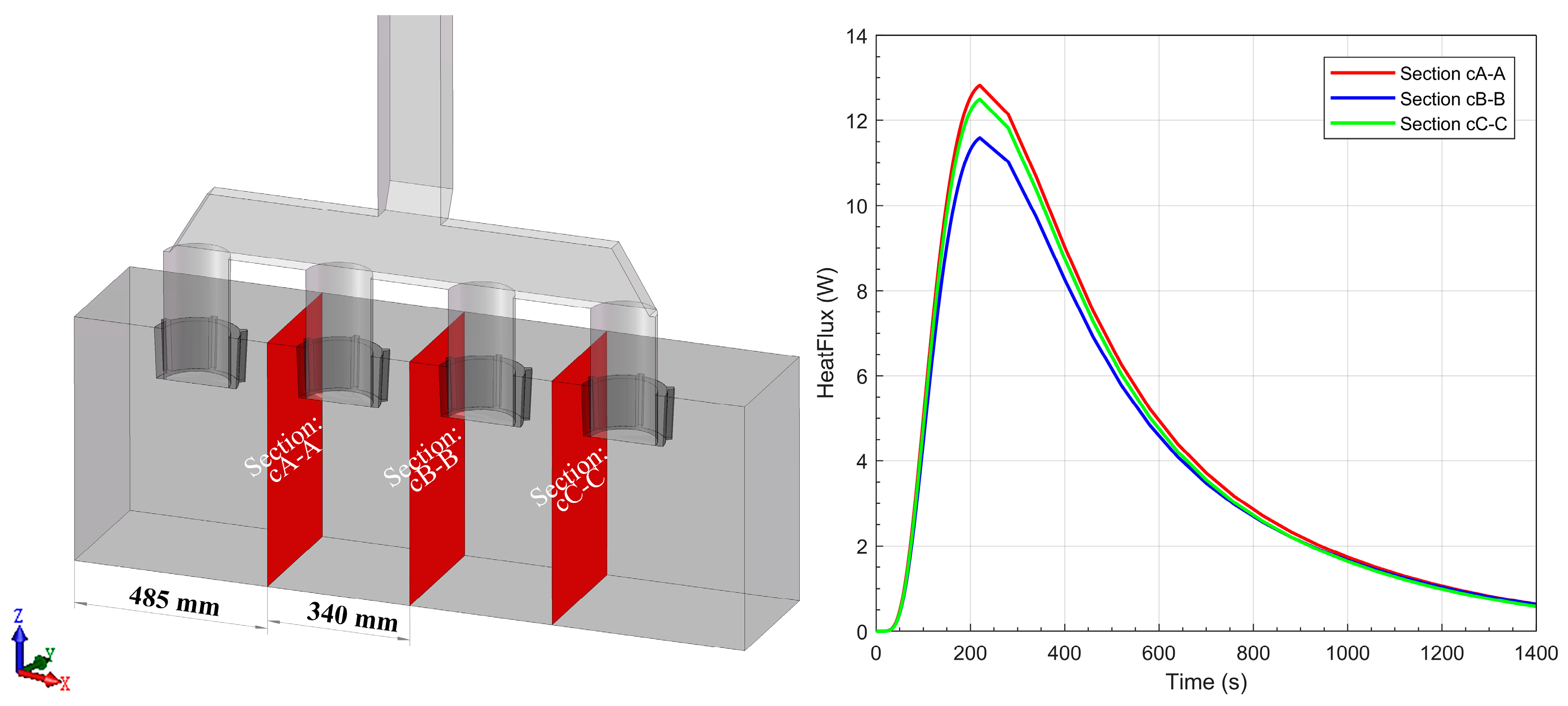
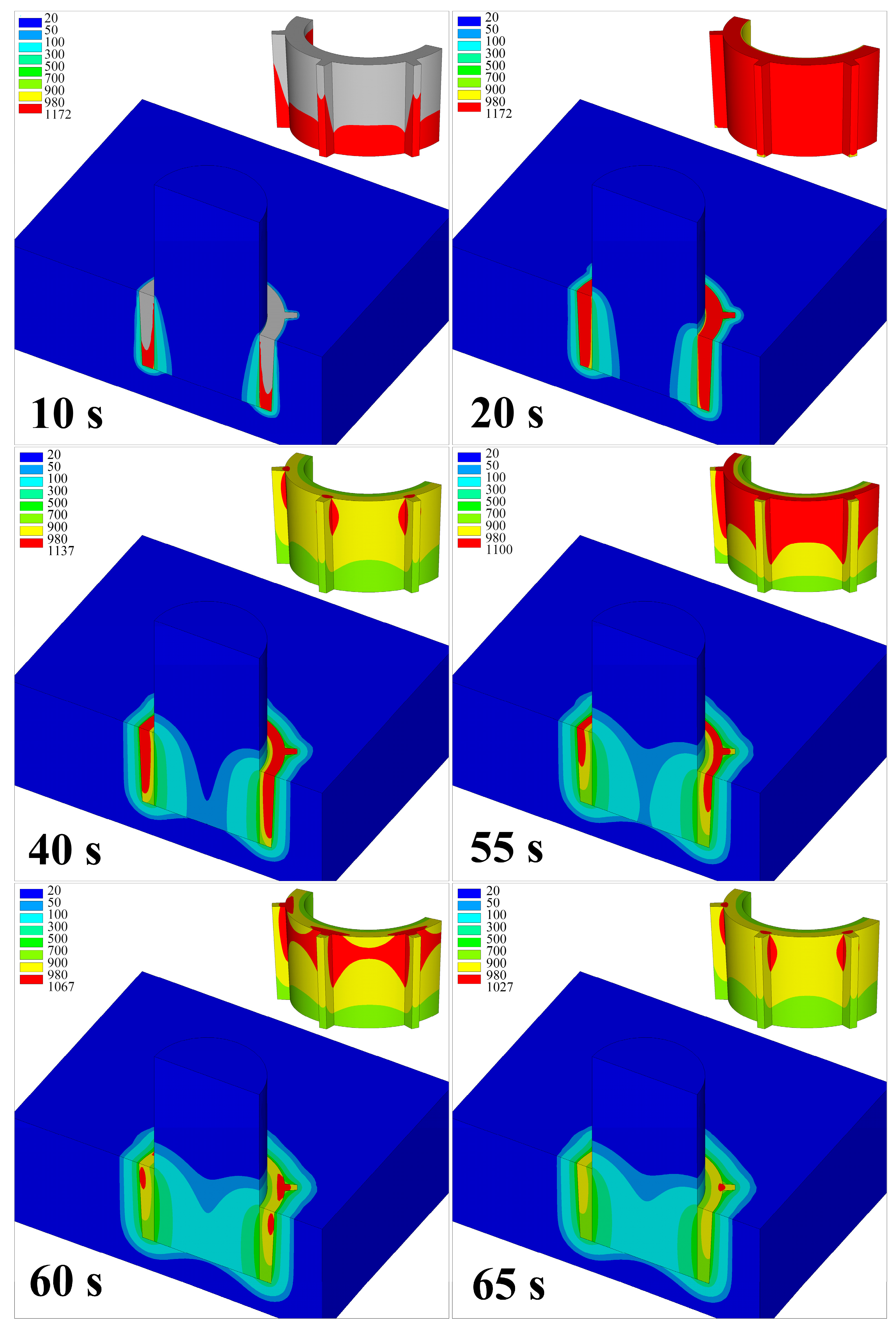
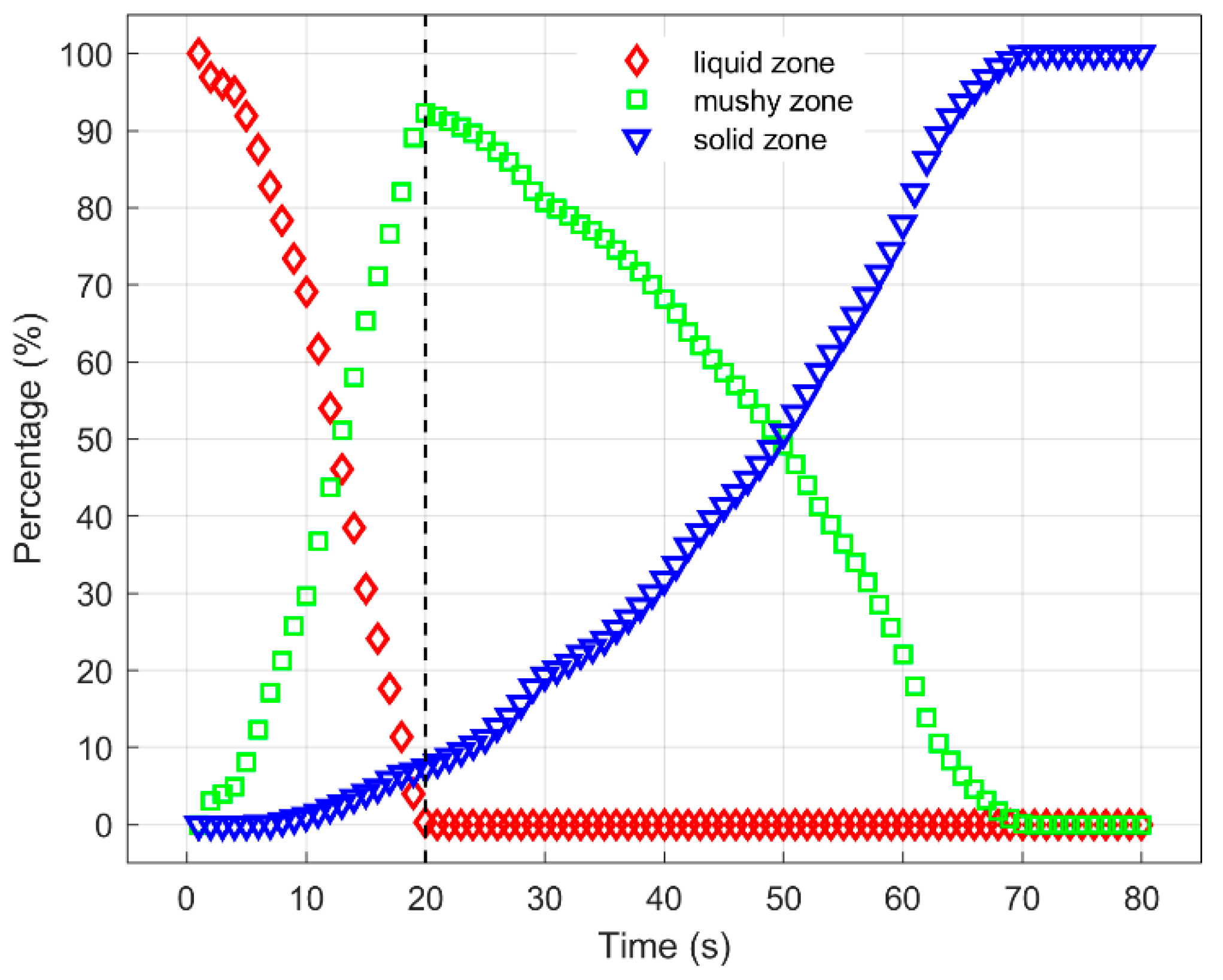
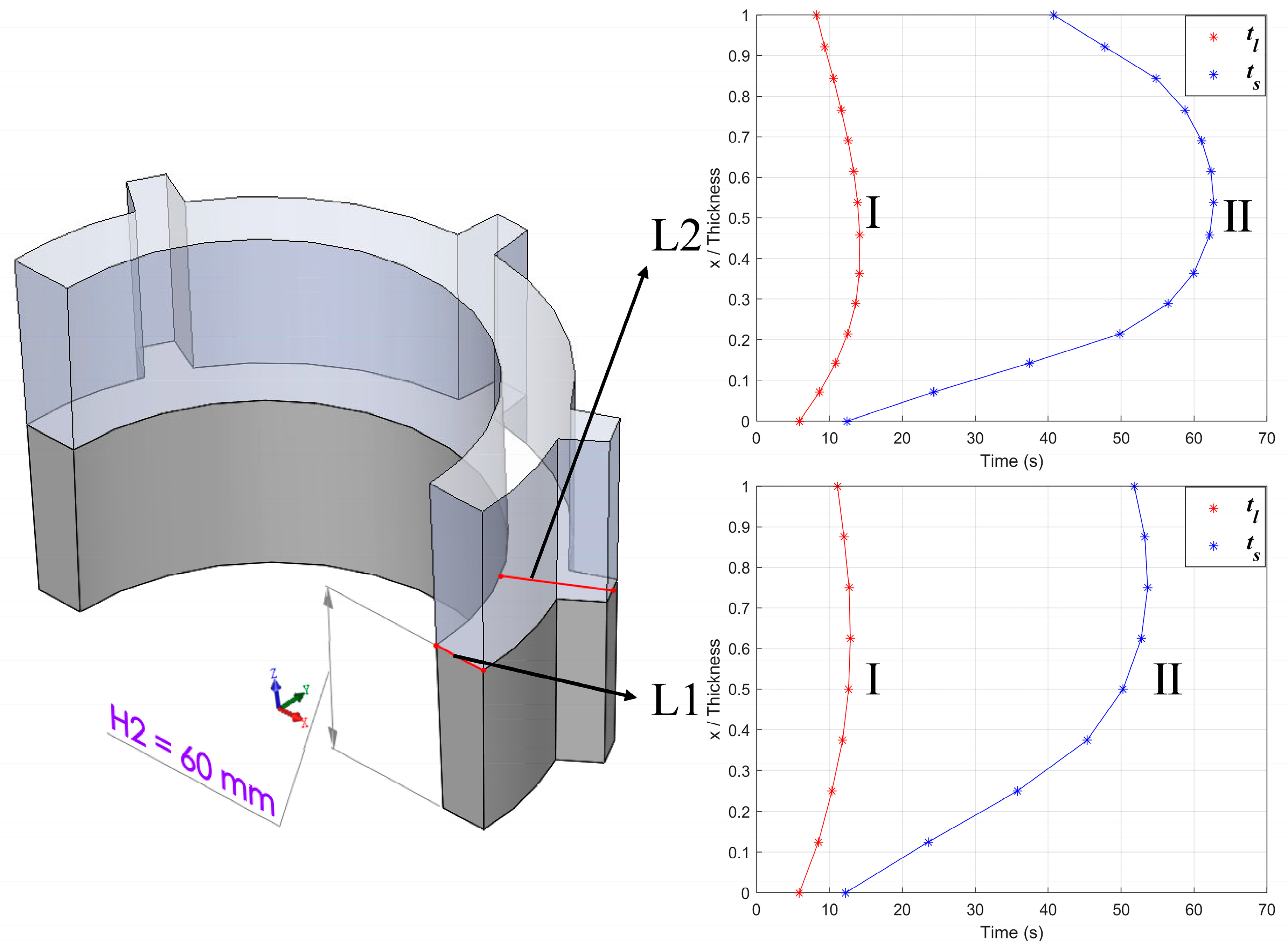


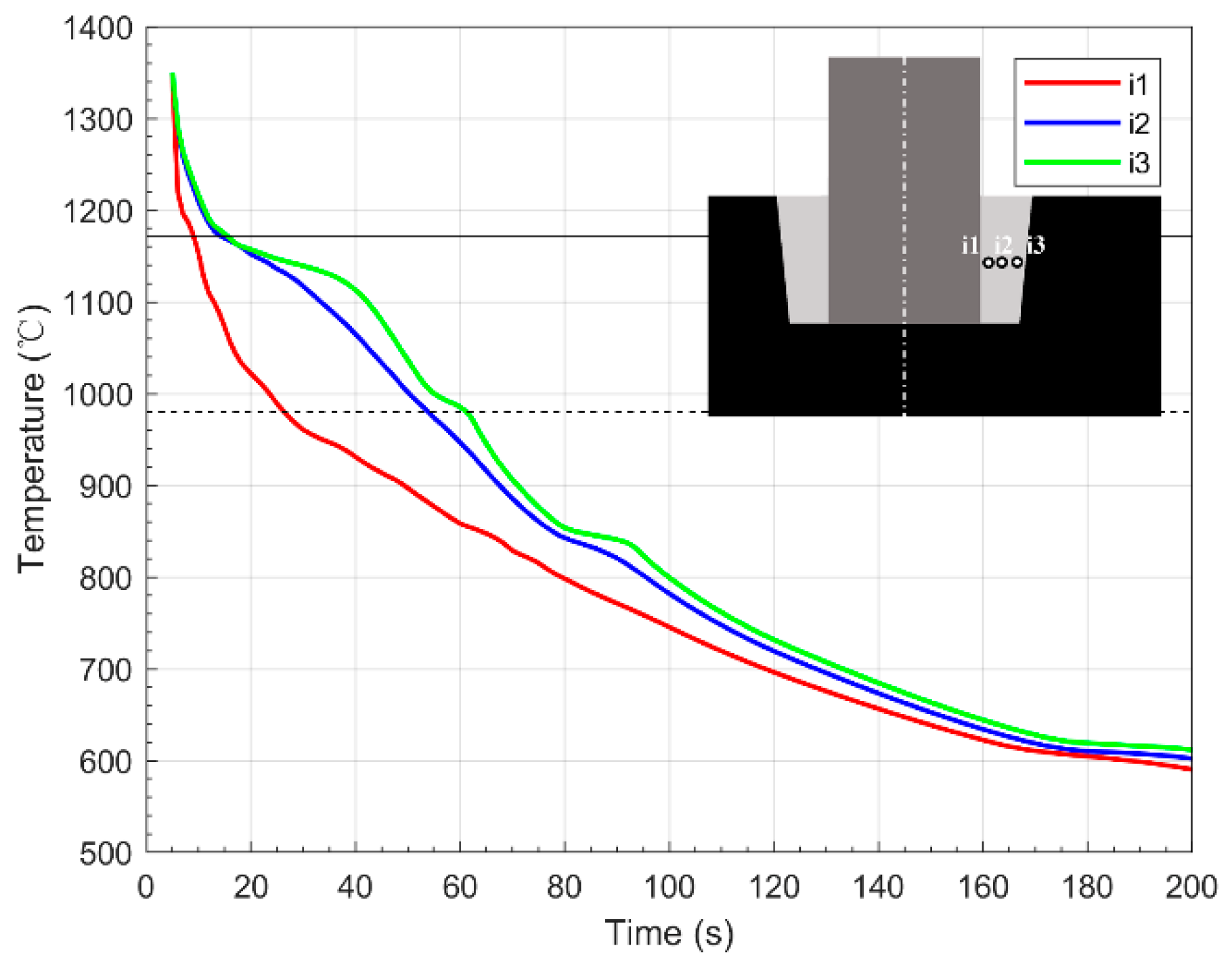
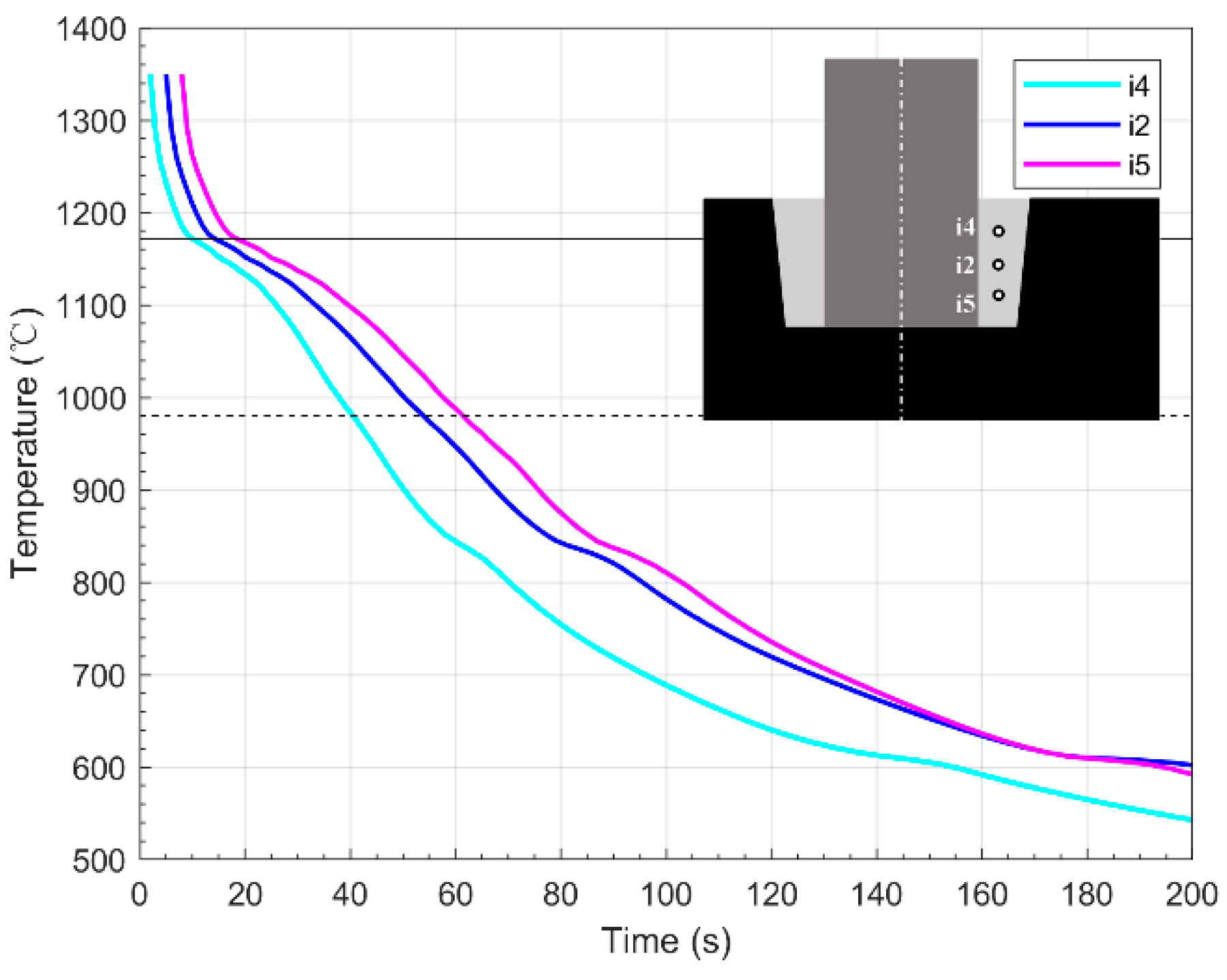


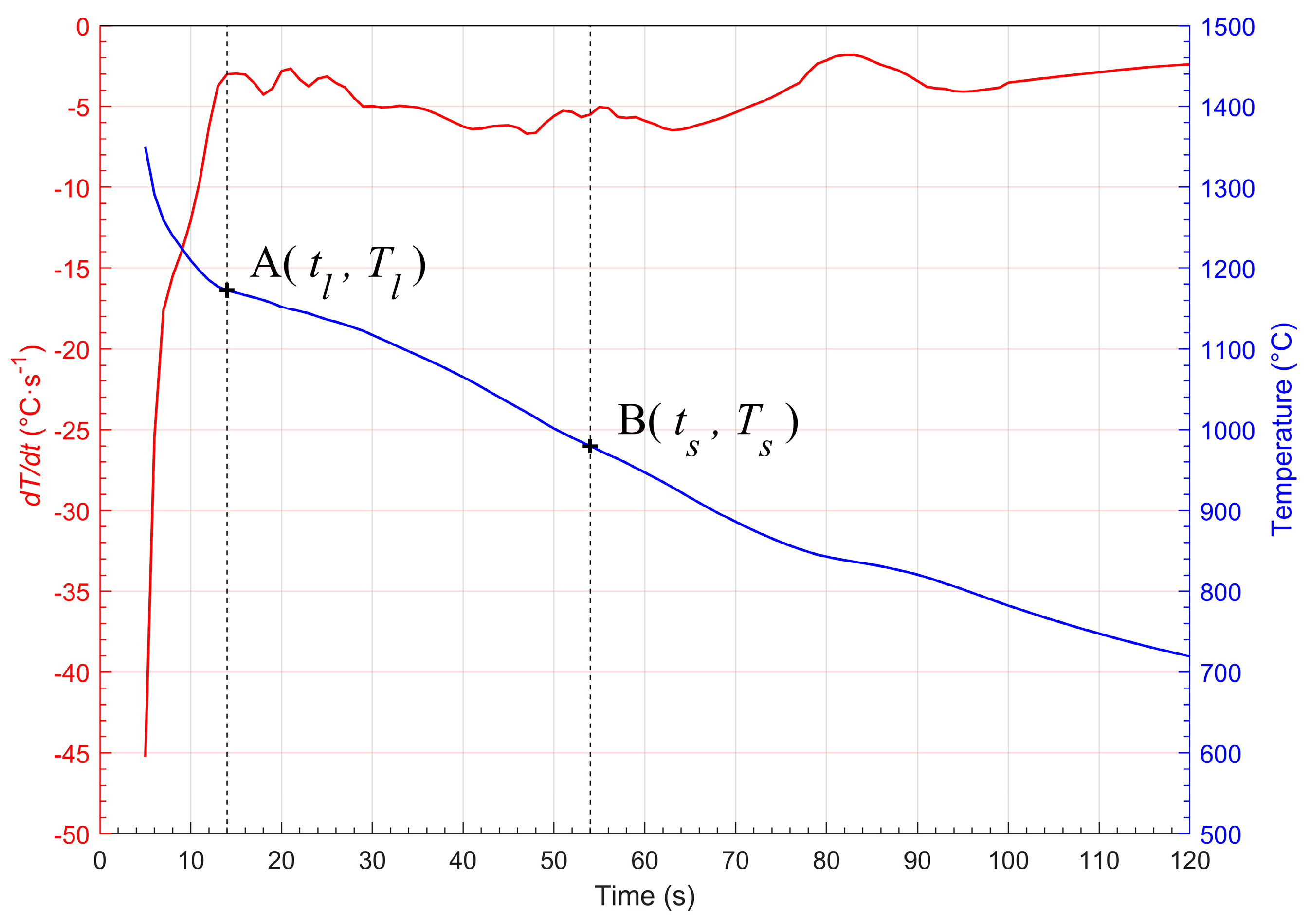
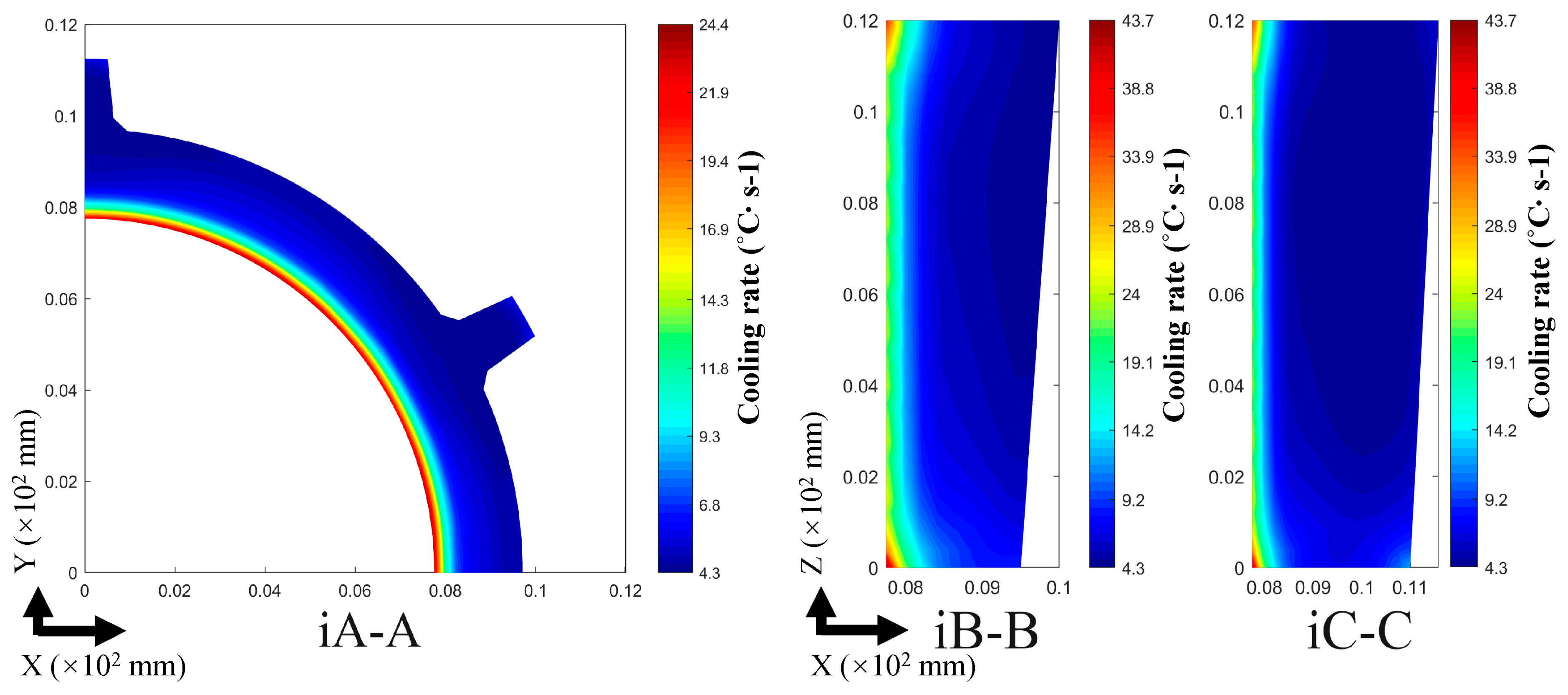
| Component | Dimension (mm) | Component | Dimension (mm) |
|---|---|---|---|
| Carbon block | 1650 × 680 × 620 | Anode rod length | 1500 |
| Stub diameter | 155 | Anode rod section | 150 × 150 |
| Stub hole depth | 120 | Stub hole diameter | 190–200 |
| Element | Content/wt % |
|---|---|
| Fe | 92.11 |
| C | 2.94 |
| Si | 3.02 |
| Mn | 0.59 |
| P | 1.21 |
| S | 0.13 |
| CE * | 4.35 |
| Heat transfer mode | Boundary conditions | Coefficient (W·m−2·°C−1) |
|---|---|---|
| Thermal contact conductance | Cast iron–Carbon | 1000 (T ≥ 1172 °C) |
| 500 (T < 1172 °C) | ||
| Cast iron–Stub | 2500 | |
| Stub–Carbon | 1000 | |
| Convection heat transfer | Stub, Yoke, Rod, Carbon–Air | 30 |
| Multimode heat transfer | Cast iron–Air | Variable as in Figure 7 |
© 2018 by the authors. Licensee MDPI, Basel, Switzerland. This article is an open access article distributed under the terms and conditions of the Creative Commons Attribution (CC BY) license (http://creativecommons.org/licenses/by/4.0/).
Share and Cite
Li, T.; Tao, W.; Wang, Z.; Liu, X.; Hou, J. Numerical Simulation on the Transient Temperature Field of Anode Rodding in Aluminium Reduction Cells. Metals 2018, 8, 1026. https://doi.org/10.3390/met8121026
Li T, Tao W, Wang Z, Liu X, Hou J. Numerical Simulation on the Transient Temperature Field of Anode Rodding in Aluminium Reduction Cells. Metals. 2018; 8(12):1026. https://doi.org/10.3390/met8121026
Chicago/Turabian StyleLi, Tuofu, Wenju Tao, Zhaowen Wang, Xiaozhen Liu, and Jianfeng Hou. 2018. "Numerical Simulation on the Transient Temperature Field of Anode Rodding in Aluminium Reduction Cells" Metals 8, no. 12: 1026. https://doi.org/10.3390/met8121026
APA StyleLi, T., Tao, W., Wang, Z., Liu, X., & Hou, J. (2018). Numerical Simulation on the Transient Temperature Field of Anode Rodding in Aluminium Reduction Cells. Metals, 8(12), 1026. https://doi.org/10.3390/met8121026




